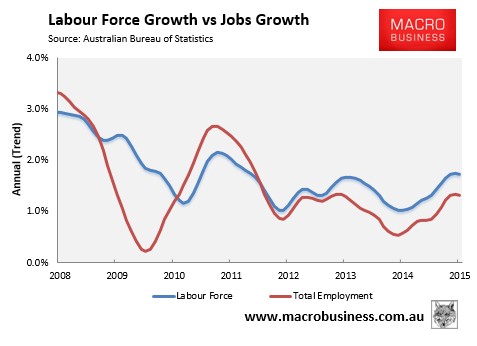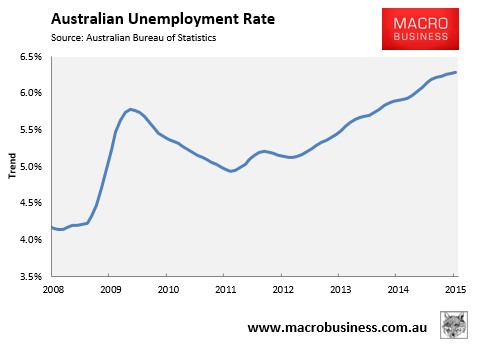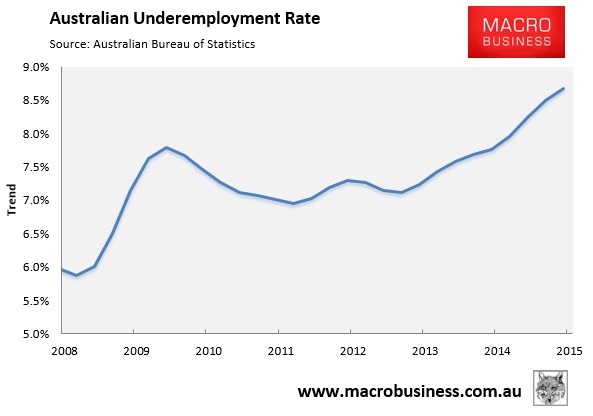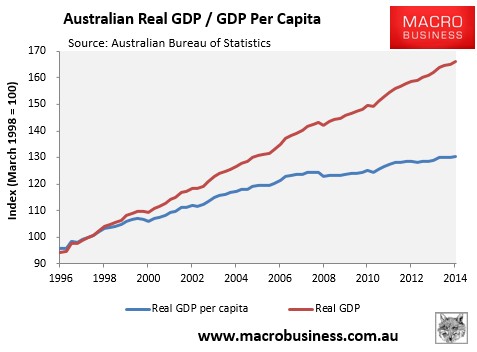…rapid population growth has been a vital support to the Australian economy since the global financial crisis…
Apart from Luxembourg, there is only one other advanced country with a population growth rate above 1 per cent and that is Canada at 1.1 per cent… Australia’s population is rising more rapidly than those of India, Mexico or Indonesia and is only just behind Pakistan and The Philippines.
Faster population growth means stronger markets for retailers, home builders, health providers, banks and the countless array of consumer-facing businesses. It has also added to the demand for infrastructure… Population growth is the reason house prices are strong, and is driving the mini housing construction boom that has been under way for the past 18 months.
Since 2008, Australia’s GDP per person has only been rising at an average of 0.7 per cent, or barely a third of the long-term average before the crisis of 2.2 per cent. Elevated population growth has lifted total economic growth to an average of 2.5 per cent over the last six years…[Migrants’] addition to demand during periods of soft growth generates more jobs than they take up. Were it not for population growth, businesses selling to consumers would be cutting staff numbers and unemployment would be much higher.
Let’s dissect Uren’s arguments one-by-one.
First, the claim that rapid population growth means “stronger markets for retailers, home builders, health providers, banks and the countless array of consumer-facing businesses” as well as housing.
It is true that growing the population is an easy way for businesses to sell more goods and services. Immigration also gives businesses access to lower cost workers. And there’s less need to become more efficient when your customer base is growing inexorably. Rather, just sit back and watch the profits flow.
Take, for example, Australia’s banks, which get the double bonus of not just having more consumers to sell debt to, but also extra demand for housing, which helps to support house prices and their loan collateral, especially given the urban consolidation policies operated by Australia’s states.
But what is missing from Uren’s analysis is that while the big end of town is a clear winner from rapid population growth, it doesn’t wear many of the costs. That is borne by everyone else.
It is you and I that will be forced to spend more time in traffic jams as Australia’s infrastructure – already straining after a decade of rampant immigration – fails to keep up with population growth.
It is you and I that will be called upon to pay for expensive new infrastructure (e.g. roads, rail and desalination plants) in a futile bid support the rapidly growing population.
It is our children that will be required to live in smaller and more expensive housing, often further away from the CBD, as more people flood into our major capital cities.
And it is our children that will be called upon to once again ramp-up the immigration intake once the current batch of migrants grows old and needs support – the very definition of a ponzi scheme.
Where is the acknowledgement of these costs, or the admission that rapid immigration can actually lower productivity by diverting investment away from productive areas (see yesterday’s post)?
Uren’s claims about economic benefits are also spurious.
Economic growth through population is an illusion – it expands the economic pie (more inputs equals more outputs) but leaves everyone’s share of that pie unchanged.
One only needs to view the below chart to see what I am talking about. Despite enjoying the biggest mining investment boom in history, per capita real GDP has risen by a paltry 4.8% since September 2008, versus 15.9% growth in overall real GDP (see next chart).
So more than two-thirds of Australia’s economic growth has come entirely from population growth, with growth in per capita terms anaemic at best, despite the huge mining investment boom over that period.
Nor does Uren’s claim that migrants’ “addition to demand during periods of soft growth generates more jobs than they take up” stand up to scrutiny. Sure, employment has been growing, but it has not grown at anywhere near the level required to soak-up the extra workers from immigration (see next chart).

Hence the rising unemployment:

And underemployment:

Uren has also failed to acknowledge that Australia earns its way in the world mainly by selling its fixed mineral resources (e.g. iron ore, coal, natural gas, and gold). More people means less resources per capita. A growing population also means that we must deplete our mineral resources faster, just to maintain a constant standard of living.
No, the key criteria that needs to be met in deciding whether to expand the immigration intake is: “will it improve the living standards of the pre-existing population”? The answer to this question seems to be a resounding “no”.
As I noted yesterday, if all Australia is doing is growing for growth’s sake, pushing against infrastructure bottlenecks, diluting our fixed endowment of minerals resources, and failing to raise the living standards of the existing population, what’s the point?


